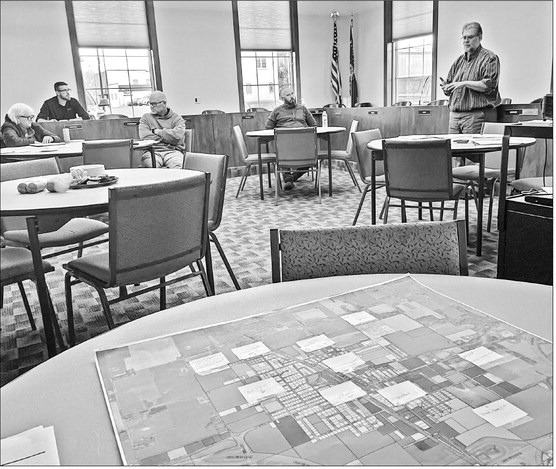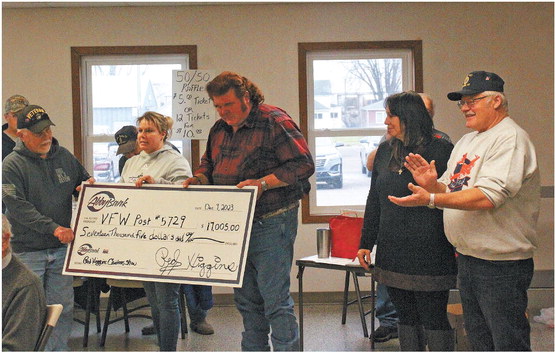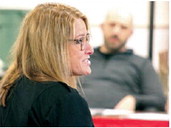Abby seeks more input for comp plan


By Kevin O’Brien
As Abbotsford embarks on an update of its nearly 20-year-old comprehensive plan, city officials are looking to get more residents involved in a process that relies on public input regarding issues such as downtown development, public safety, housing and transportation.
All of these topics were discussed at a meeting of the planning commission last Wednesday, which included a lengthy discussion with Chris Straight, senior planner at the West Central Wisconsin Regional Planning Commission (WCWRPC), which has been hired to rewrite the comp plan in accordance with state statutes.
Straight told commissioners that the updating process is about 45 days behind the original schedule, which calls for the updated plan to be adopted in June or July of next year.
“We can still get this done within the original schedule,” he said.
The current plan, adopted in 2005, was technically due for an update back in 2015 according to state law, but Straight said the most important consideration is whether the city’s zoning and mapping decisions are consistent with the existing plan.
“So, by having this plan, you’re covering your bases in terms of making zoning decisions,” he said. “An exception to that rule is conditional use permitting, so those conditions don’t necessarily have be consistent or laid out in that comp plan.”
Later in the meeting, for instance, the commission voted to approve a conditional
See COMP PLAN/ Page 5 Comp plan
Continued from page 1
use permit for La Takeria El Nopal, a new restaurant planned for the former Napa Auto Parts store on STH 13. Because the property lies within the city’s highway commercial district, it automatically requires a conditional use permit.
Last Wednesday’s meeting was the second of six meetings slated to take place by next May or June as part of the comp plan update. A significant amount of the conversation was dedicated to reviewing the results of a community survey taken between July and August, which only drew 122 responses from the city’s population of over 2,000.
“It doesn’t necessarily represent the entire community, but it’s still helpful for understanding the group that responded, what those folks are thinking,” Straight said.
Overall, the survey showed that respondents are happy for the most part with the city’s quality of life, with 85 percent saying they are either satisfied or very satisfied. Results were more mixed, however, on other questions, such as whether “the overall character of Abbotsford should continue to be much like it is today.” About 54 of the respondents either agreed or strongly agreed with that statement, while 34 percent disagreed or strongly disagreed and 12 percent were not sure or had no opinion.
When it comes to government services, a strong majority of respondents, about 82 percent, said “ensuring public safety” was their top priority. Maintaining streets and utilities was a distant second at about 43 percent.
Straight said the emphasis on public safety was a bit of a “red flag” for him, and he asked commissioners if residents are “not feeling entirely safe” in the city.
City administrator Josh Soyk said he does not believe the crime rate is necessarily up in the city, though the number of fines issued has increased.
“I think it’s more of a perception thing, honestly,” he said.
Commissioners agreed with Soyk, noting that some people say they don’t feel as safe as they used to at night, but that doesn’t necessarily mean they stay inside when the sun goes down.
“I have some people who voice that concern, but they’re still going out for walks at night,” said Ald. Roger Weideman, noting that the local police force does a good job keeping the city safe.
The survey results indicate strong confidence in local law enforcement, with 32 percent rating them as “excellent” and 53 percent saying they are “good.” Similar ratings were given to other emergency services, including firefighters and medical responders.
One survey question about housing revealed how skewed the results were on that topic, with nearly 93 percent of the respondents indicating they own their own homes. Straight said less than 3 percent of the city’s renters, which are sizable part of the population, responded to the survey.
“So, the survey’s not representing those renter units,” he said. “Especially when it comes to housing, we don’t know what they’re thinking, what their needs are, their desires are.”
Responses to another question showed that most respondents rated the overall quality and appearance of the city’s housing as either fair (51 percent) or good (34 percent). A vast majority of the respondents have lived in Abbotsford for at least 10 years, with about 60 percent having resided in the city for 25-plus years.
In order to get better information on residential needs, Straight said the city will need to rely on a housing focus group that has been formed as part of the comp planning process. The group has already met twice since the city signed its contract with WCWRPC in May, and Soyk said he expects to have a third meeting after the holidays in January.
At the beginning of this year, Abbotsford was awarded a $14,550 Community Development Block Grant in order to update its comp plan, and in May, the city hired WCWRPC to assist with the process.
Downtown concerns
Responses to a few of the questions, along with comments submitted by respondents, revealed deeply mixed feelings about the city’s downtown. Less than a third of the respondents agreed that Abbotsford’s downtown is “vibrant, attractive and inviting,” while 43 percent disagreed and 22 percent strongly disagreed.
“Our Main Street has been an embarrassment for years,” one commenter wrote. “Fixing the roads and the sidewalks should be a priority and not be put off every year.”
Soyk said the city had originally planned to redo Main Street in 2026, but that has been pushed back closer to 2030, so now he’s questioning whether that planning process should really be part of the comp plan update as initially envisioned.
Commissioners Mason Rachu and Paul Erikson both said they would prefer to hold off on Main Street planning until the city is closer to doing any actual project.
“As much as we’re changing, a lot can change in five years,” Erikson said.
Straight said today’s cities and villages don’t need as much retail space as they used to, so some communities are embracing more of a mixed-use downtown that includes a smaller core of commercial businesses with more housing developments nearby.
“Our downtowns were built for a different era,” he said. “They were the Super Wal-Marts of the 1900s, so they had all of the different businesses. They filled the whole street.”
However, a few of the survey comments showed less concern about empty storefronts and more about the changing nature of downtown, which currently includes several Hispanic-owned businesses, including three restaurants, two grocery stores, a clothing store, and a kids arcade.
“We are turning into Mexico downtown!” one comment said.
Another commenter said there are too many Hispanic stores downtown, and the city needs more manufacturing and “stores for all.” Other comments referred to downtown as “sad-looking” and “rundown and deserted.”
At the same time, however, over twothirds of respondents said they visit downtown to shop or eat out at least a couple of times every month, with about a third saying they never do.
Straight wondered if the comp planning process should focus more on how to “bring the community together,” perhaps by having someone facilitate a public discussion at the school or other public venue. Soyk suggested having an event on a Saturday at city hall, with snacks and beverages served, when people can provide their input for Main Street and the city as a whole.
Commissioners said they need to figure out how to get Hispanic residents over their reluctance to participate in the planning process so that it’s not so narrowly focused on the desires of longtime residents who filled out the survey.
“It seems like, from the survey, we’re really gathering information from a very small part of the community,” Erikson said.
Straight agreed to reach out to members of the Hispanic community before the next planning session in January and develop a strategy for broadening the city’s outreach efforts.
“Sounds like a plan,” Straight said. Commissioners also discussed the transportation part of the plan, but no major directives or plans were brought up. In response to a question about increased pedestrian options, Soyk said the city has recently installed walking paths at Schilling Park and around the K-12 campus, but residents have consistently opposed the placement of additional sidewalks in front of their residences.
MAPPING OUT A PLAN - An existing land use map of Abbotsford was on display during an Abbotsford Planning Commission meeting last Wednesday that focused on updating the city’s 2005 comprehensive plan. Chris Straight, senior planner at the West Central Wisconsin Planning Commission, standing at right, speaks with planning commissioners Sharon Archambo, left, Mason Rachu and Paul Erikson, along with city administrator Josh Soyk.
STAFF PHOTO/KEVIN O’BRIEN



